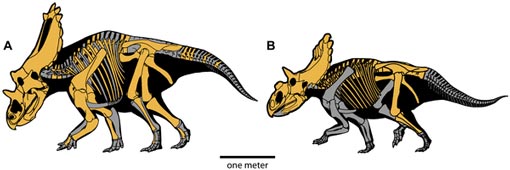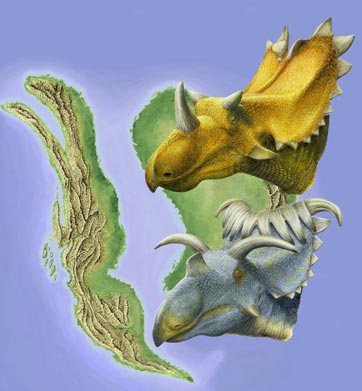The Curious Ceratopsians just got a Little Peculiar
Two New Genera of Ceratopsian Announced
Just when one complete review of the phylogeny of a particular clade of the Dinosauria is carried out then Mother Nature throws a horned-dinosaur sized spanner in the works with the discovery of new types of ceratopsian. We are eagerly awaiting our copy of the recently published “New Perspectives on Horned Dinosaurs”, but already we fear that new finds will have rapidly outdated the information contained in this book.
Two New Genera
Two new genera of ceratopsian dinosaur (horned dinosaurs) were officially announced yesterday (Wednesday) and put on display at the Utah Museum of Natural History in Salt Lake City. Both have been described as “weird and wonderful” as each genus sported some very impressive head gear.
The two new horned dinosaurs have been named Kosmoceratops richardsoni (the name means Richardson’s ornate horned face) and Utahceratops gettyi (Getty’s horned face from Utah). Both these new types of herbivorous dinosaurs have been assigned to the Chasmosaurinae – a group of advanced horned dinosaurs, typically with long neck shields, and brow horns bigger than any nose horn. These large animals roamed what today is the Grand Staircase-Escalante National Monument in southern Utah around 75 million years ago (Late Campanian faunal stage). The discovery of these two types of horned dinosaur in the same strata indicates that these animals lived at the same time (co-occurring), many scientists had thought that these types of dinosaurs lived at different times in the Late Cretaceous, this new discovery and other recent finds from western North America challenge this view and further complicate our understanding of Late Cretaceous eco-systems.
These Utah discoveries lend support to the theory that there were distinct bio-geographical provinces of Dinosauria in North America during the last few million years of the Cretaceous Period. The fossil record indicates that the major ornithischian groups, the hadrosaurs and ceratopsians for example, underwent a spectacular radiation and a number of new genera evolved, both these types of ornithischian dinosaur show extensive diversification in terms of genera; leading to a number of dinosaur types being restricted to specific geographical locations. This theory, as to the provincial eco-systems of mega fauna is much debated, but the discovery of these two ceratopsians adds weight to the hypothesis of dinosaur endemism – dinosaurs being unique to a region. Put simply, it is like having different ethnic groups of dinosaurs restricted to certain areas. If this hypothesis is correct it raises some interesting questions – such as why the diversification of Ornithischian dinosaurs in the Late Cretaceous, why the establishment of distinct “provinces” of dinosaurs and why only in certain parts of the world (that relatively thin strip of land on the western borders of the interior seaway – Laramidia)?
To read more about this theory: Ethnicity in North American Dinosaurs.
The paper detailing these discoveries and their potential implications is published in the online scientific journal PLoS ONE (Public Library of Science). U. gettyi is known from at least six individual specimens, including two partial skulls which together provide palaeontologists with over 95% of the skull and nearly three-quarters of the postcranial skeleton (the rest of the body). Kosmoceratops richardsoni is known from four individual specimens, one of which provided a near completely preserved skull. Although, less fossil material of K. richardsoni has been excavated to date, scientists estimate that they have unearthed approximately half the skeleton.
An Illustration of U. gettyi and K. richardsoni

Picture credit: PLoS ONE/Utah Museum
Ceratopsian Dinosaur
The larger ceratopsian dinosaur (Utahceratops gettyi) is A, whilst the smaller K. richardsoni can be seen on the right of the illustration, notation B. A scale bar of one metre is shown and the areas shaded indicate the fossil material recovered.
The Utahceratops skull is more than two metres in length with horns that grow sideways out of the skull like a those of a cow. Kosmoceratops has fifteen horns, some also growing sideways, along with ten curving down from the top of the fan-shaped neck shield. Kosmoceratops has more horns than any other known genus of horned dinosaur, hence the reference to “ornate” in its scientific name.
Scott Richardson, an amateur palaeontologist and seasonal worker helping to map and explore the geology of southern Utah, discovered the first fossils of Kosmoceratops back in 2006. He was exploring an area of the Kaiparowits Plateau when he found a baseball-size piece of bone. More pieces of bone were found nearby and he took his finds to Mike Getty, Palaeontology Collections Manager at the Utah Museum of Natural History.
Richardson said:
“The next day [Getty] came into town and I asked him about the bone. He said it was nothing but a big grin came across his face and he said it was an incredible find.”
Scott is very honoured to have a new species of dinosaur named after him stating that it was “awesome”.
Utahceratops honours the state of Utah, the second dinosaur to be named after this American state (the first was the theropod Utahraptor). Mike Getty first found evidence of Utahceratops ten years ago, but it has taken the research team and field workers nearly a decade to find and piece together all the fragments of bone. The species name reflects that it was Getty who found the first fossil evidence. Unfortunately, the fossil material was spread over an extensive area and assembling the skeleton has been like “putting together a puzzle”.
These two new dinosaurs make a total of sixteen new species discovered in the area over the last eleven years or so. Scientists at the Utah Museum are optimistic about finding many more. The fossils are going to go on public display along with other finds from the dig sites.
An Illustration of the Two New Ceratopsians

Picture credit: Utah Museum of Natural History
Utahceratops and Kosmoceratops
The picture shows the head of Utahceratops above that of the smaller Kosmoceratops. In the background is a map of North America approximately 75 million years ago. At this time in Earth’s history, much of the area now known as North America was covered by a shallow tropical sea (The Western Interior Seaway). The strip of land to the west (Laramidia) seems to have been home to a very diverse population of large dinosaurs, but there is evidence to suggest distinct “ethnic groups” of dinosaurs, different types of animal restricted to different areas. In the absence of any known natural barriers such as mountains or an extensive river system, scientists remain puzzled by this apparent phenomenon.
The arrangement of the horns and other elements of ornamentation on these dinosaurs is certainly bizarre. Side-ways facing brow horns would have limited practical use as defensive weapons when inter-specific competition is considered, such as an attack from a large tyrannosaur. However, they may have had a display function or have been used in intraspecific combat in the same way that bison “lock horns” in ritual combat to decide herd status and to win mates.
Since this article was written, CollectA have introduced models of Kosmoceratops and Utahceratops into their not-to-scale model range.
To view these figures (whilst stocks last): CollectA Age of Dinosaurs Popular Range.

